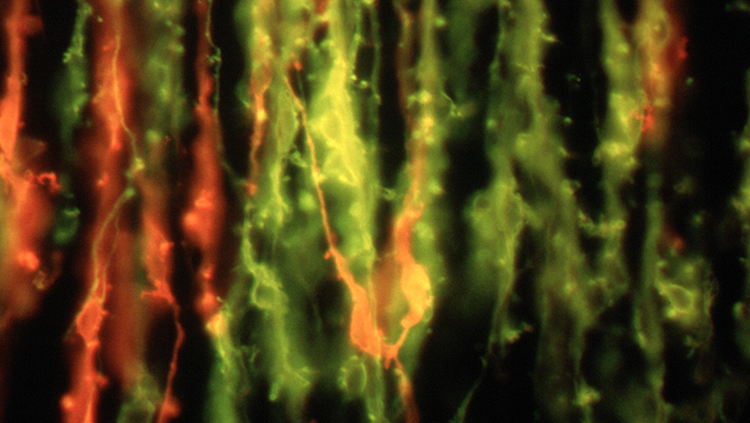What’s Behind a Cough?
- Published5 Jul 2022
- Author Daphne Yao
- Source BrainFacts/SfN

You’ve most likely coughed as you’ve breathed in dust particles or allergens. The spicy flavors of sriracha or jalapeños may also have triggered a coughing fit. While the coughs may sound the same, different processes underlie each. Dust particles trigger a reflexive cough whereas that spicy food triggers a voluntary cough. One that, believe it or not, you could easily resist.
Sara Prescott, an assistant professor of biology at Massachusetts Institute of Technology, conducts research on airway neurons and the reflexes they elicit, including the cough reflex. In conversation with BrainFacts.org, Prescott discusses the pathways underlying the cough reflex and when coughing could be beneficial or harmful for your body.
What’s happening in your body when you feel a cough?
The sensory neurons triggering cough come through the vagus nerve, which innervates the respiratory tract. At least three different types of nerve fibers in the vagus nerve induce coughing:
- Vagal nociceptors. Aside from reacting to capsaicin, the active ingredient in hot chili peppers, these nerve fibers respond to chemical irritants like acid or nicotine.
- Vagal water receptors. These neurons innervate special cells in the larynx to sense water that has been accidentally inhaled.
- Vagal mechanosensors. The fibers react to mechanical stimuli like foods, dust particles, or mucus.
There are several sites that can trigger a cough in the airway in this manner, but the larynx, or voice box, is especially sensitive. This structure sits where the top of the airway branches to other parts of the respiratory system, including the lungs. Through being sensitive, the larynx prevents food from entering down into the respiratory system.
How is the cough reflex different from a voluntary cough?
Separate receptors and circuitry initiate these two behaviors, even at the most peripheral level. These pathways then integrate into networks in the brainstem, which trigger the motion of coughing. Reflexive cough reflexes are evoked by stimuli like water and are easier to study because they can be induced under anesthesia.
On the other hand, capsaicin triggers the urge to cough rather than a true reflexive cough, as these coughs can be volitionally suppressed and are not seen under anesthesia.
How is the reflex different in health, during allergies, and in disease?
For people who have asthma, chronic cough, or other diseases, the neurons in the protective reflexes are more sensitive. So, coughs are triggered more easily.
On the flip side, your reflexes can also be too insensitive. If the neurons are not sensitive enough, you won’t have enough airway protection. It’s common to find your airway defensive reflexes becoming less sensitive when you age, which is why the elderly are particularly vulnerable to lung infections and pneumonia.
What are the effects of coughing too much or forcing coughs?
In conditions like chronic coughing or severe asthma, cough might become excessive, meaning that they’re not productive or beneficial for the human body. Repeated excessive coughing damages the airway mucosa, a membrane lining the airway that serves to moisten the airways.
What are the benefits of the cough reflex?
The big purpose is to prevent obstruction or infection of the airways. An example of obstruction would be when we choke on something we eat, while infection of the airway with viruses could lead to diseases like pneumonia. So defensive reflexes like the cough reflex not only protect our airways from particles in the outside environment like pathogens or pollens, but they also serve a purpose internally: to save us from the risk of objects blocking our airways.
References
Canning, B. J., Chang, A. B., Bolser, D. C., Smith, J. A., Mazzone, S. B., McGarvey, L., & CHEST Expert Cough Panel (2014). Anatomy and neurophysiology of cough: CHEST Guideline and Expert Panel report. Chest, 146(6), 1633–1648. https://doi.org/10.1378/chest.14-1481
V. Courtney Broaddus MD, in Murray & Nadel's Textbook of Respiratory Medicine, 2022
BrainFacts.org welcomes all your brain-related questions.
Every month, we choose one reader question and get an answer from a top neuroscientist. Always been curious about something?
Please submit your question by filling out this form.









